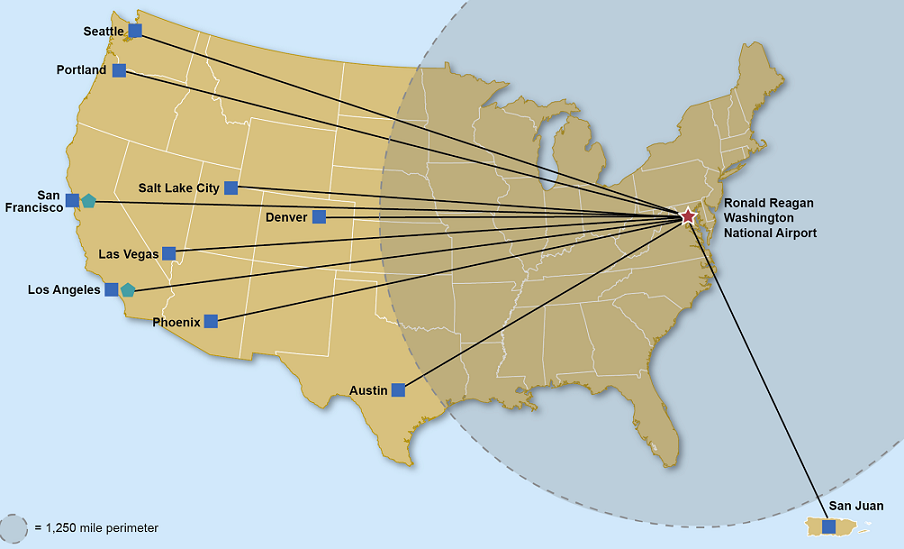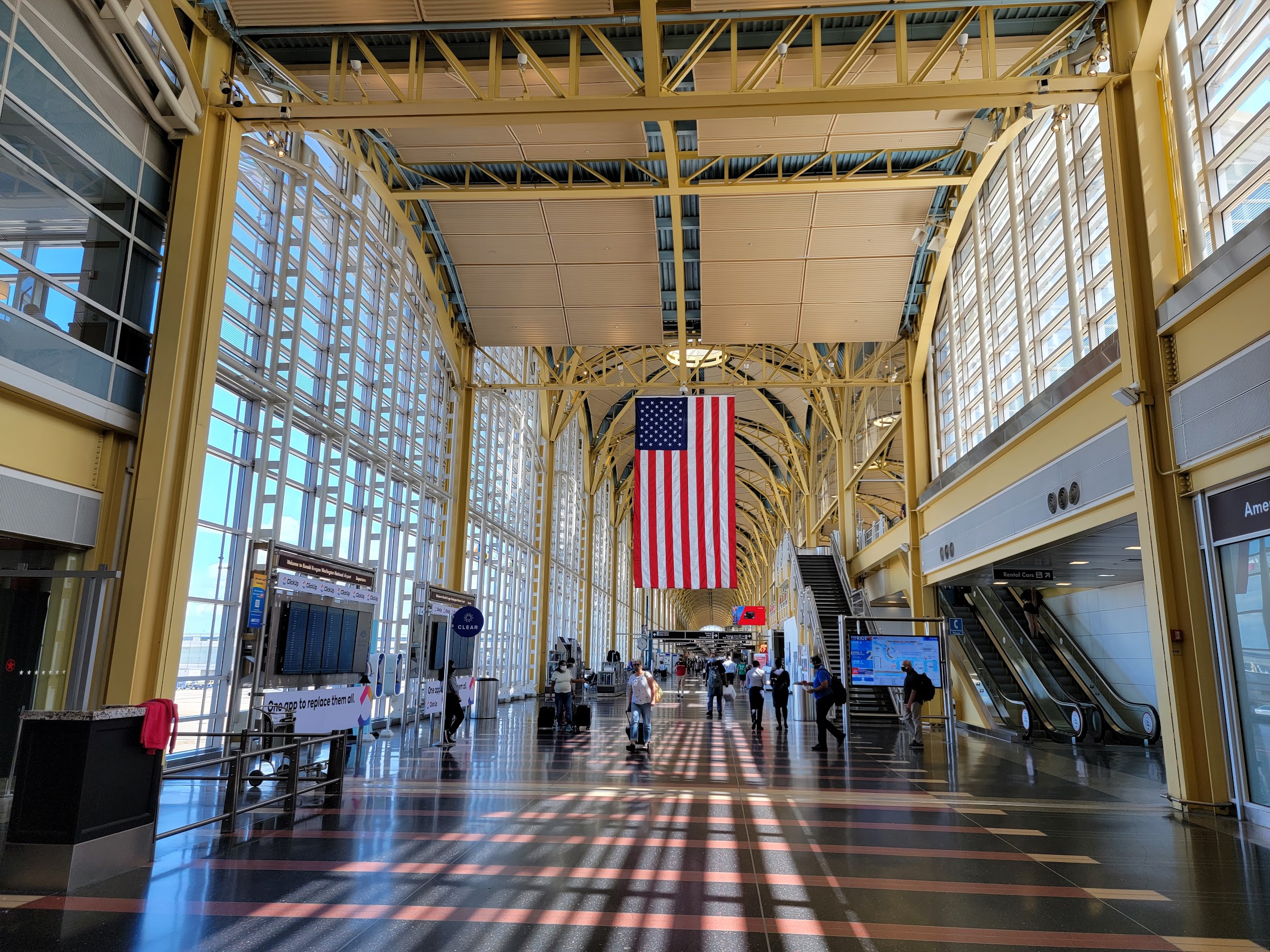Flights from Washington’s National airport are limited to 1,250 miles unless they are one of a handful of exception flights provided for in legislation and handed out by the Department of Transportation.
In the Spring Delta launched a lobbying effort to expand the 20 ‘beyond perimeter’ roundtrips a day at the airport. They don’t want to eliminate the rule, adopted in part to protect the growth of Washington Dulles for long distance flying before it had yet developed on its own, because that would help American Airlines too much – American has a majority of takeoffs and landings at the slot-controlled airport.
A beyond perimeter flight is valuable. Southwest Airlines, for instance, has the only legally-permitted flight between National airport and Austin. No other airline is allowed to compete on that route. Other options either involve connections or going to Dulles.

Other goals of the perimeter rule were limiting congestion (longer flights might mean larger planes) and limiting noise. But the airport can’t regularly handle aircraft larger than a Boeing 757 anyway due to the length of its main runway and noise concerns are much less of an issue with more modern aircraft than when rules were put in place 57 years ago.
- In the spring Delta had proposed 28 new roundtrip per day, hoping to gain many of those for themselves.
- Going nowhere, over the summer they scaled back their ask to 7 new daily slots.
- While United opposes any growth at National as a threat to its business at Washington Dulles, American – which has over half the slots at National and didn’t want to see its position diluted – softened its opposition. Southwest came out in favor.

National Hall
United Airlines has a major operation at Washington Dulles and benefits from the perimeter rule because their long-distance flights don’t have competition at closer-in National airport. Perhaps the major reason that the perimeter rule hasn’t been displaced is that United Airlines consistently lobbies for it to remain.
Dulles airport has received over $300 million in passenger fees over 10 years transferred from National airport in order to keep United’s costs low so that it doesn’t leave. The Commonwealth of Virginia has also kicked in $50 million.
The local airport authority, keen to keep United happy at Dulles and to mollify constituents near National airport who abhor the idea of growth, opposes any new beyond-perimeter slots and they’ve added a poison pill to their proposed new airport master lease to kill any effort by Congress to allow them.
This lease provides that any airline taking advantage of a new beyond-perimeter slot at National airport would have to pay $1 million annually to support Dulles airport. This would circumvent Congress’ authority to expand flying from National airport, with a $2,700 per day fee – making taking advantage of the slot uneconomic.
Senator Ted Cruz (R-TX) is asking the airport authority for records of communications with United as well as astroturf lobbying groups over this position. He, along with Senator Maria Cantwell (D-WA), had supported legislation that would have allowed 4 new beyond perimeter slots and he’s seeking additional flights to Texas (Dallas and Houston are within the perimeter, San Antonio and Austin are not).
“MWAA is not United Airlines’ corporate lobbyist, nor should it be,” Cruz wrote.
The dueling coalitions have marshaled arguments and counterarguments since the idea to add flights was pitched in April. Supporters say that it would reduce airfares and that Dulles no longer needs to be protected by restrictions at its older, sister airport. But opponents say National already is at capacity, pointing to an FAA analysis that concluded that more flights would mean more delays.
National airport, formally named for Ronald Reagan, is a congested airport. It lacks gate and terminal space. But it’s not really above intended flying capacity, because slot allocations assumed private jet movements throughout the day that are no longer permitted.

National Airport Historic Terminal
Ultimately the battle here is over which airline gets subsidies – the exclusive right to fly in and out of the airport gifted to it by the government (slots) or protection from competition. Neither is a good approach. Congestion pricing would be far more market-based and pro-competitive, but there won’t be any airlines currently holding slots that would support this.
(HT: Enilria)


Mark,
yes, I do have access to better data (international O&D data) which CF and others admit they do not have.
You and others simply do not bring data to the
DL is not expected to order enough aircraft to replace all of its 767s – 300ERs and 400s.
and UA’s 767 fleet is not any younger than DL’s. it is simply a little smaller. DL is going to start retiring its remaining 767s in 2024.
You are beyond delusional if you think that UA will use its much larger fleet orders even halfway for growth.
UA has an older domestic fleet than DL and also far more RJs which UA will have to retire.
As much as you want to blather on and on, UA does not have any advantage, will take on far more debt or not generate profits as large as DL because of much higher UA capex and UA will have to spend far more on terminals and fight much more battles to gain domestic market share than UA will.
Repeating the same thing that a.net and other know it all doesn’t make you smarter or me without self-aware.
Scott Kirby is trying to desperately to convince everyone how smart he is and yet there isn’t a single thing that is a long term strategic advantage that he has done that someone else didn’t do first.
If UA was as well-run as you think they are, Wall Street would see it in higher profits and higher valuation – neither of which is the case.
btw, DL has more mainline aircraft in service now than AA or UA and will be the first US airline to reach 1000 mainline aircraft.
DL will take delivery of more new widebodies in 2024 than UA.
DL generates more revenue and profits than UA and that will continue into 2024
Stop drinking the United koolaid and face actual facts.
Tim, we’ll agree to disagree.
thank you, Mark.
more importantly, look critically at all of the rah-rah PR that comes from United instead of finding fault with everything that Delta or anyone else says.
UA simply cannot do half of what it thinks it can do unless other carriers achieve as much or more.
If United was running as good of an airline and business as you and Scott Kirby believe, Wall Street would be convinced. United as a company is worth just 52% of what Delta is worth, Wall Street analysts have higher buy ratings on DAL than UAL, and DAL has demonstrated that they can and will go where money is made as fast as United and make be more profitable in the process.
Scott Kirby is a career airline manager. Airlines are very tribal. United has tried many times to be the largest and most profitable airline and has not achieved it in decades.
They are free to keep trying and you are free to cling to the hope that they will finally do it but my track record of discussing the airline industry speaks for itself. Whether people like what I say is far from my motivation.
And specific to this discussion, it is very unlikely that the $1 million per flight poison pill on outside perimeter DCA flights will survive and everyone except for UA will benefit.
You can always count on Tim claiming data that he doesn’t have to support a thesis that isn’t correct all to win an argument in a comments section against a random person he doesn’t know… 🙂
And yes, Tim… you don’t seem to know much about the AA/US or UA/CO consolidation in concourse T so just move along when you’ve made it clear to everyone you’re ill-informed.
WTH did you come up with ANY concourses in this discussion, MAX?
Get back w/ me after the first YEAR when United outperforms Delta on just one of 1. annual revenues 2. annual profits or 3. market capitalization.
for right now, despite all of their blather about fleet growth, they are #3 out of the big 3 in mainline fleet size and might pass AA on the way to 1000 but not DL.
The entire Scott Kirby/United NEXT narrative is built on the notion that United alone will be able to grow, United is capable of achieving whatever it wants regardless of the competitive environment, and United will be able to afford its spending when it is perfectly obvious that Delta is growing as fast as United, Delta is spending less to grow, and Delta is generating larger profits.
again, let us know when the script flips the way you THINK it will change while **I** will focus on reality and facts.